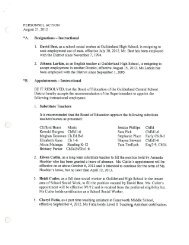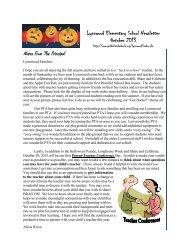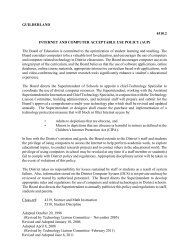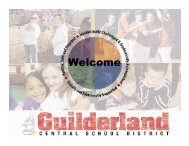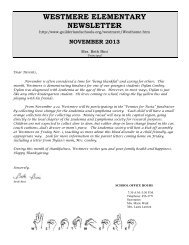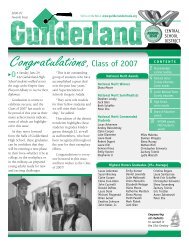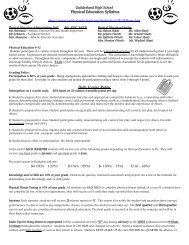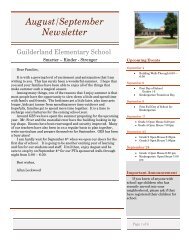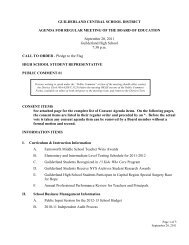How to Bring Our Schools Out of the 20th Century - Guilderland ...
How to Bring Our Schools Out of the 20th Century - Guilderland ...
How to Bring Our Schools Out of the 20th Century - Guilderland ...
Create successful ePaper yourself
Turn your PDF publications into a flip-book with our unique Google optimized e-Paper software.
This is evident, for example, when students:<br />
• Exchange simple greetings and answer questions about self and family.<br />
• Listen <strong>to</strong> various media broadcasts and answer questions about main ideas.<br />
• Speak in complete sentences, using present tense and, occasionally, markers for past<br />
and future tenses.<br />
• Ask for information or directions.<br />
• Discuss classroom activities with a peer.<br />
• Use appropriate body language and gestures <strong>to</strong> supplement <strong>the</strong> spoken word.<br />
Standard 2: Cultural Understanding<br />
Effective communication involves meanings that go beyond words and require an<br />
understanding <strong>of</strong> perceptions, gestures, folklore, and family and community dynamics. All <strong>of</strong><br />
<strong>the</strong>se elements can affect whe<strong>the</strong>r and how well a message is received.<br />
Students can:<br />
• Use some key cultural traits <strong>of</strong> <strong>the</strong> societies in which <strong>the</strong> target language is spoken.<br />
This is evident, for example, when students:<br />
• Recognize cultural patterns and traditions <strong>of</strong> <strong>the</strong> target cultures in <strong>the</strong> target<br />
language;<br />
• Understand <strong>the</strong> cultural implications <strong>of</strong> <strong>the</strong> spoken language and <strong>the</strong> dynamics <strong>of</strong><br />
social interaction; and<br />
• Correctly use and interpret cultural manifestations, such as gestures accompanying<br />
greeting and leave taking and <strong>the</strong> appropriate distance <strong>to</strong> maintain.<br />
Questionnaires will be provided <strong>to</strong> students, parents, teachers and administra<strong>to</strong>rs <strong>to</strong> obtain<br />
feedback about <strong>the</strong> FLES Program near <strong>the</strong> end <strong>of</strong> each school year. The end-<strong>of</strong>-year survey will<br />
<strong>the</strong>n allow us <strong>to</strong> measure any observable changes in attitude over time.<br />
Timeline for Implementation <strong>of</strong> FLES<br />
Spring, 2004<br />
May, 2004<br />
May, September, 2004<br />
Oc<strong>to</strong>ber, 2004<br />
November, 2004<br />
December, 2004<br />
January 6, 2005<br />
Form a planning committee composed <strong>of</strong> teachers, Board <strong>of</strong> Education<br />
member, supervisor, principals and parents.<br />
FLES Committee meets and establishes a goal and timeline for<br />
implementation <strong>of</strong> <strong>the</strong> program. Implementing Successful FLES<br />
Programs by Dr. Elaine Margarita is used as a resource.<br />
FLES Committee reviews research and approaches for integrating<br />
language and culture in<strong>to</strong> <strong>the</strong> elementary program.<br />
FLES Committee members visit four successful FLES programs and<br />
report back <strong>to</strong> <strong>the</strong> committee.<br />
FLES Committee selects Spanish as <strong>the</strong> language <strong>to</strong> be taught K-5 and<br />
agrees on a tentative schedule.<br />
FLES Subcommittee writes <strong>the</strong> FLES Proposal.<br />
FLES Committee meets <strong>to</strong> review FLES Proposal.<br />
14



